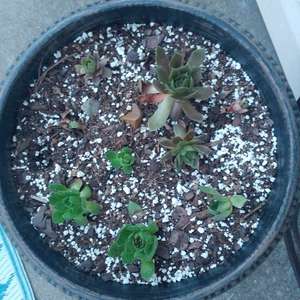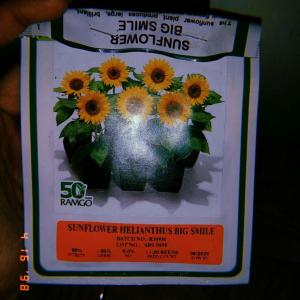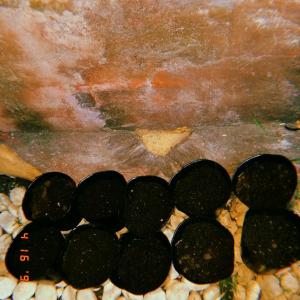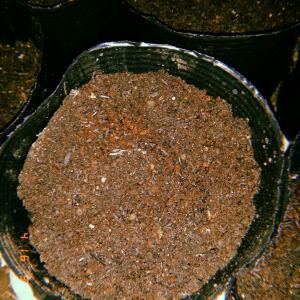文章
Miss Chen
2018年06月04日

Description: This perennial wildflower is 1½–3' tall and unbranched or sparingly branched. The stout central stem is erect, medium green, hairless, and terete. Basal leaves are usually cordate or oval-cordate with long petioles; sometimes they are odd-pinnate with 2 small lateral leaflets and a large terminal leaflet. The cauline leaves occur in opposite pairs along the stem and they are odd-pinnate with 3-7 leaflets. Each cauline leaf is up to 8" long and 4" across. The leaflets are more or less ovate in shape; the terminal leaflet is larger than than the lateral leaflets. The leaflets are medium green, hairless, and smooth to slightly dentate along their margins. Each cauline leaf is sessile at the base, or it has a short petiole. The central stem terminates in a short dense panicle of flowers that becomes more elongated with age. Much smaller panicles of flowers may develop from the axils of the upper leaves. Each flower has a slender funnelform corolla with 5 spreading lobes; this corolla is white to light pink and about ½–¾" long. Exerted from each corolla, there are 3 stamens and a slender style. At the base of the flower, there is a green calyx that is much shorter than the corolla.
The blooming period occurs from late spring to early summer and lasts about a month. Each flower has a single-celled ovary that produces a single achene. Each achene has a tuft of plume-like hairs; the achenes are distributed in part by the wind. The root system is fibrous and its produces occasional rhizomes or stolons. Sometimes small colonies of plants develop from the rhizomes or stolons.
Cultivation: The preference is light shade to partial sun, consistently moist conditions, and fertile soil with abundant organic matter. The foliage is rarely bothered by disease or insects.
Range & Habitat: The native Large-Flowered Valerian is occasional in extreme east-central, southeast, and southern Illinois; elsewhere in the state, it is largely absent (see Distribution Map). Illinois lies at the western range-limit for this species. Habitats include floodplain woodlands along streams or rivers, shaded ravines, and bottoms of rocky canyons. This species is found in high quality habitats that are moist and shady.

Faunal Associations: Information about floral-faunal relationships for this species is very limited. The long slender corollas suggests that the flowers are pollinated by bumblebees, butterflies, Sphinx moths, and possibly hummingbirds. The nectar of the flowers is inaccessible to most insects with short mouthparts.
Photographic Location: The wooded bottom of a sandstone canyon at The Portland Arch in west-central Indiana. In the flowerhead close-up, most of the flowers are still in the bud stage.
Comments: This is the showiest Valeriana sp. in Illinois. Its flowers exceed ½" in length, while the flowers of other native and naturalized Valeriana spp. are less than ½" in length. Large-Flowered Valerian should be cultivated more often. Sometimes, this species is called Pink-Flowered Valerian.
The blooming period occurs from late spring to early summer and lasts about a month. Each flower has a single-celled ovary that produces a single achene. Each achene has a tuft of plume-like hairs; the achenes are distributed in part by the wind. The root system is fibrous and its produces occasional rhizomes or stolons. Sometimes small colonies of plants develop from the rhizomes or stolons.
Cultivation: The preference is light shade to partial sun, consistently moist conditions, and fertile soil with abundant organic matter. The foliage is rarely bothered by disease or insects.
Range & Habitat: The native Large-Flowered Valerian is occasional in extreme east-central, southeast, and southern Illinois; elsewhere in the state, it is largely absent (see Distribution Map). Illinois lies at the western range-limit for this species. Habitats include floodplain woodlands along streams or rivers, shaded ravines, and bottoms of rocky canyons. This species is found in high quality habitats that are moist and shady.

Faunal Associations: Information about floral-faunal relationships for this species is very limited. The long slender corollas suggests that the flowers are pollinated by bumblebees, butterflies, Sphinx moths, and possibly hummingbirds. The nectar of the flowers is inaccessible to most insects with short mouthparts.
Photographic Location: The wooded bottom of a sandstone canyon at The Portland Arch in west-central Indiana. In the flowerhead close-up, most of the flowers are still in the bud stage.
Comments: This is the showiest Valeriana sp. in Illinois. Its flowers exceed ½" in length, while the flowers of other native and naturalized Valeriana spp. are less than ½" in length. Large-Flowered Valerian should be cultivated more often. Sometimes, this species is called Pink-Flowered Valerian.
0
0
文章
Miss Chen
2018年05月28日

Description: This herbaceous plant is 1-2½' tall with an ascending leafy stem that is unbranched. The central stem is light to medium green, slightly zigzag, and glabrous to short-pubescent. Alternate leaves occur along this stem that are 2-5" long and 1-2½" long; they are broadly elliptic in shape, smooth (entire) along their margins, and sessile. The upper leaf surface is medium to dark green and glabrous, while the lower leaf surface is pale to medium green and finely short-hairy along the major veins (a 10x hand lens may be required to see this). Leaf venation is parallel with 3-7 prominent veins. Flowers are produced individually or in groups of 2-3 from the axils of most leaves; they are suspended below the leaves on short peduncles and pedicels. Each flower is 8-14 mm. in length and narrowly cylindrical in shape, consisting of 6 pale greenish yellow to greenish white tepals, 6 inserted stamens, and a 3-celled ovary with a single style. Around the outer rim of each flower, there are 6 straight to slightly recurved lobes about 2-3 mm. in length. The filaments of the stamens are minutely warty and terete. The peduncles and pedicels are light green, slender, and glabrous; they are about ¼-½" in length during the blooming period, but become about ½-1" in length when berries are produced.
The blooming period occurs from mid- to late spring, lasting about 3 weeks. During the summer, the flowers are replaced by berries. At maturity, these berries are dark blue-violet to black, globoid in shape, and often glaucous; they are 6-9 mm. across. The interior of these berries is fleshy with several seeds. Individual seeds are 1.5-3.0 mm. long, globoid in shape, and either tan or straw-colored. The root system has knotty rhizomes up to ½" thick. Small clonal colonies are often produced from these rhizomes.
Cultivation: The preference is partial sun to medium shade, moist conditions, and soil containing either loam or sandy loam with decaying organic matter. Most growth and development occurs during the cool weather of spring.

Range & Habitat: The native Hairy Solomon's Seal is rare in northern Illinois, while in the rest of the state it is absent (Distribution Map). It is state-listed as 'endangered.' Illinois lies along the southern range limit of this species (excluding mountainous areas in the Appalachians). Habitats include moist to mesic woodlands, sandy woodlands, and lower slopes of forested sand dunes near Lake Michigan. In Illinois, Hairy Solomon's Seal is found in higher quality natural areas.
Faunal Associations: The flowers attract the Ruby-throated Hummingbird, honeybees, bumblebees, and probably other bees. These floral visitors feed primarily on the nectar, although some of the bees also collect pollen for their larvae. A small number of insects feed destructively on the foliage and plant juices of Polygonatum spp. (Solomon's Seal species). These insects include the aphids Catamergus kickapoo and Macrosiphum gei, the thrips Ctenothrips bridwelli, and caterpillars of the moth Clepsis melaleucana (Black-Patched Clepsis). The berries are probably eaten by such woodland birds as the Ruffed Grouse, various thrushes, and the Veery. These birds spread the seeds to new areas. White-tailed Deer occasionally graze on the foliage of Solomon's Seal species.
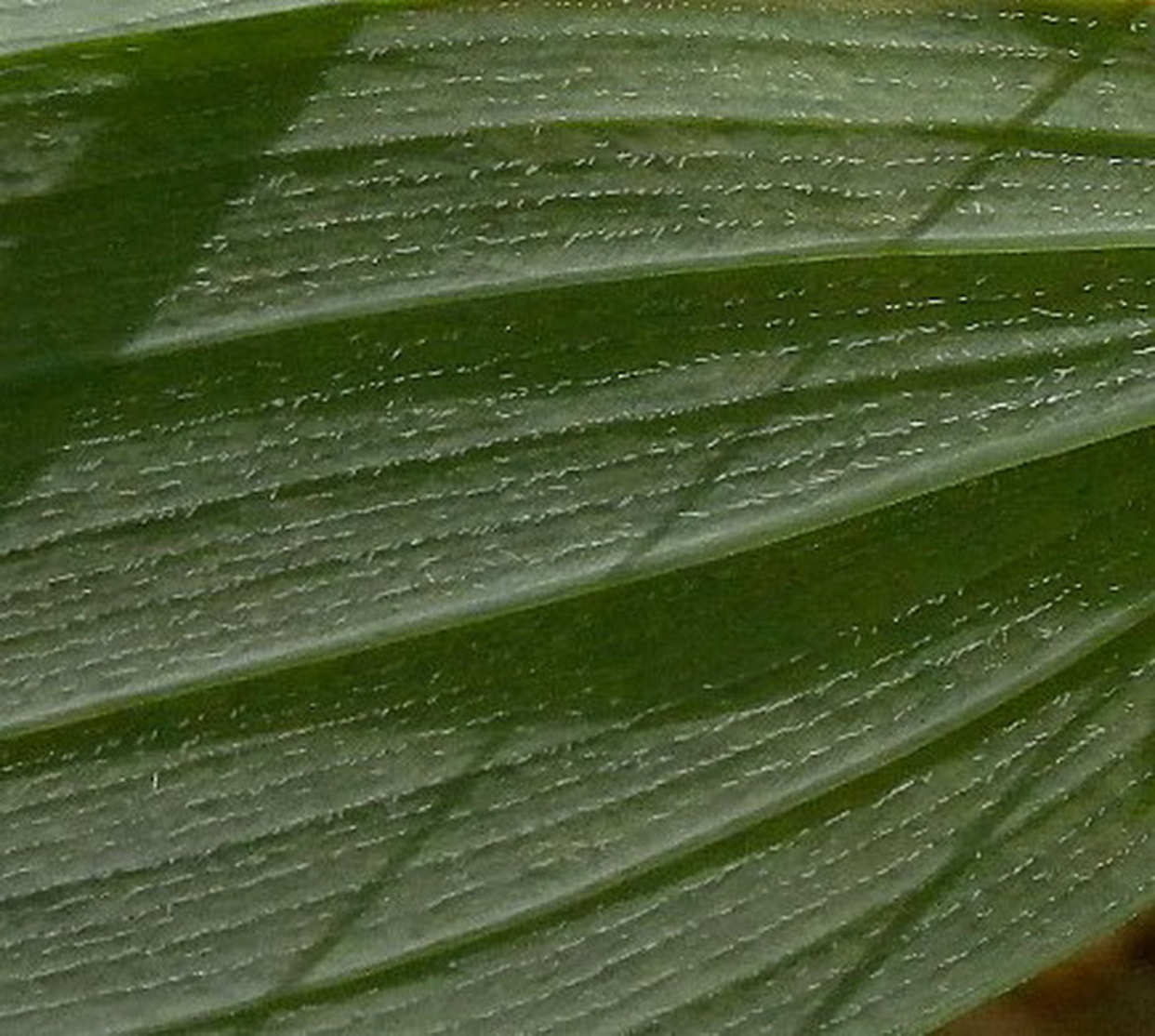
Photographic Location: A moist sandy woodland at the Indiana Dunes State Park in NW Indiana.
Comments: This species can be easily confused with the more common Polygonatum commutatum (Smooth Solomon's Seal). Hairy Solomon's Seal tends to be a smaller plant that produces fewer flowers and berries underneath its leaves (usually only 1-2 flowers or berries per leaf). It also has a tendency to bloom a little earlier in the year than the latter plant. However, the most distinctive characteristics of Hairy Solomon's Seal are 1) the short fine hairs along the veins of its leaf undersides, and 2) the warty filaments of its flowers.
The blooming period occurs from mid- to late spring, lasting about 3 weeks. During the summer, the flowers are replaced by berries. At maturity, these berries are dark blue-violet to black, globoid in shape, and often glaucous; they are 6-9 mm. across. The interior of these berries is fleshy with several seeds. Individual seeds are 1.5-3.0 mm. long, globoid in shape, and either tan or straw-colored. The root system has knotty rhizomes up to ½" thick. Small clonal colonies are often produced from these rhizomes.
Cultivation: The preference is partial sun to medium shade, moist conditions, and soil containing either loam or sandy loam with decaying organic matter. Most growth and development occurs during the cool weather of spring.

Range & Habitat: The native Hairy Solomon's Seal is rare in northern Illinois, while in the rest of the state it is absent (Distribution Map). It is state-listed as 'endangered.' Illinois lies along the southern range limit of this species (excluding mountainous areas in the Appalachians). Habitats include moist to mesic woodlands, sandy woodlands, and lower slopes of forested sand dunes near Lake Michigan. In Illinois, Hairy Solomon's Seal is found in higher quality natural areas.
Faunal Associations: The flowers attract the Ruby-throated Hummingbird, honeybees, bumblebees, and probably other bees. These floral visitors feed primarily on the nectar, although some of the bees also collect pollen for their larvae. A small number of insects feed destructively on the foliage and plant juices of Polygonatum spp. (Solomon's Seal species). These insects include the aphids Catamergus kickapoo and Macrosiphum gei, the thrips Ctenothrips bridwelli, and caterpillars of the moth Clepsis melaleucana (Black-Patched Clepsis). The berries are probably eaten by such woodland birds as the Ruffed Grouse, various thrushes, and the Veery. These birds spread the seeds to new areas. White-tailed Deer occasionally graze on the foliage of Solomon's Seal species.

Photographic Location: A moist sandy woodland at the Indiana Dunes State Park in NW Indiana.
Comments: This species can be easily confused with the more common Polygonatum commutatum (Smooth Solomon's Seal). Hairy Solomon's Seal tends to be a smaller plant that produces fewer flowers and berries underneath its leaves (usually only 1-2 flowers or berries per leaf). It also has a tendency to bloom a little earlier in the year than the latter plant. However, the most distinctive characteristics of Hairy Solomon's Seal are 1) the short fine hairs along the veins of its leaf undersides, and 2) the warty filaments of its flowers.
0
0
文章
Miss Chen
2018年05月27日

Description: This herbaceous perennial plant is 1½-3' tall and sparingly branched. The central stem is medium green, terete, and glabrous to slightly hairy, becoming somewhat broader where the bases of leaves wrap around it. On some plants, the central stem has a tendency to zigzag slightly between the alternate leaves. These leaves are up to 12" long, 2" across, and linear-lanceolate or elliptic-lanceolate in shape; they are smooth (entire) and sometimes slightly ciliate along their margins. Because of their length, the leaves have a tendency to arch downward from their bases. The upper leaf surface is dark green and glabrous to short-hairy, while the lower leaf surface is medium green and glabrous to short-pubescent (sometimes there are only minute hairs along the undersides of the veins). Leaf venation is parallel.
Sometimes secondary stems and leaves develop from the axils of the primary leaves. The central stem terminates in a floppy umbel of flowers on slender pedicels. Sometimes umbels of flowers are produced from the axils of the upper leaves or on short secondary stalks. Each flower is about 1" across when it is fully open, consisting of 3 light violet petals (rarely white), 3 medium green sepals, 6 stamens with yellow anthers, and a pistil with a single style. The petals are oval or broadly ovate, while the smaller sepals are ovate and usually hairy. The filaments of the stamens are pale violet; they are densely covered with spidery hairs. The pedicels of the flowers are about ½" long, medium green or reddish purple, and glabrous to hairy. At the base of each umbel of flowers, there is a leafy bract that is opposite from the alternate leaf; this bract is somewhat smaller in size.

The blooming period occurs during the summer, lasting about 1½ months. The flowers are diurnal, opening up during the morning and closing at about noon (although they may remain open longer on cloudy days). Each flower lasts only a single day. Because only a few flowers are in bloom at the same time, the blooming period is fairly long. Afterwards, the flowers are replaced by 3-chambered seed capsules (up to ¼" long); each of these capsules contain several seeds. The seeds are 2-3 mm. long and flattened-ovoid in shape; they have slightly indented centers, from which several fine grooves radiate outward in all directions toward their outer margins. The root system consists of a mass of fleshy fibrous roots, from which clonal offsets are occasionally produced.
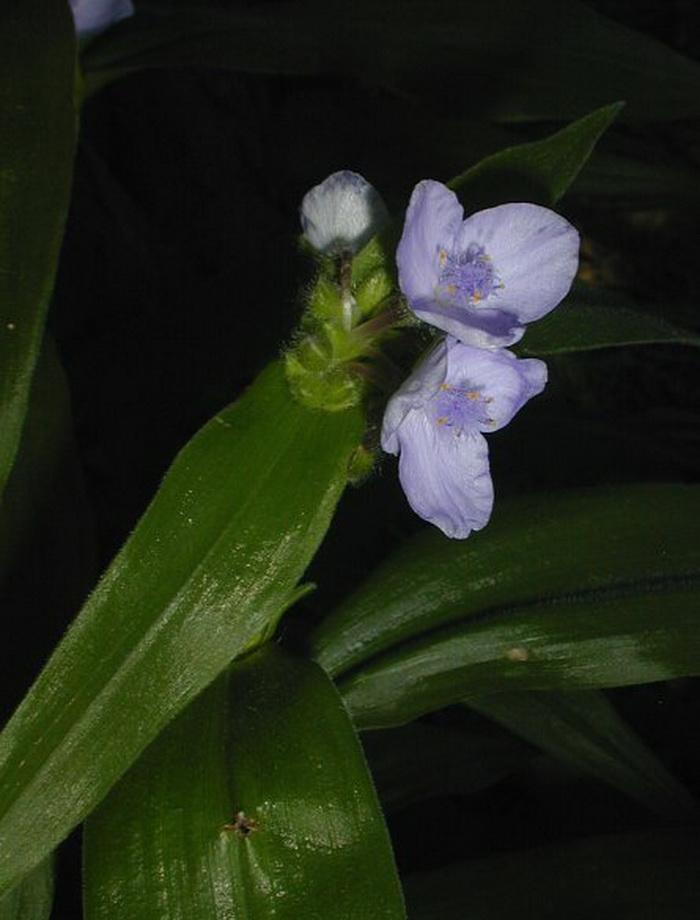
Cultivation: The preference is partial sun to medium shade, moist to mesic conditions, and a fertile loamy soil with decaying organic matter. Like other spiderworts (Tradescantia spp.), this plant is little bothered by insect pests and foliar disease. It adapts well to flower gardens in areas where there is some shade.
Range & Habitat: The native Zigzag Spiderwort occurs occasionally in the southern half of Illinois, while it is rare or absent in the northern half of the state (see Distribution Map). Habitats include rich deciduous woodlands, woodland borders, bases of bluffs, bottoms of large ravines, and shaded areas along streams. Sometimes this plant can be found in more disturbed areas, such as shaded areas along railroads, roads, and corners of yards when they are adjacent to woodlands.

Faunal Associations: The flowers are cross-pollinated by bumblebees primarily. Halictid bees, including green metallic bees, collect pollen from the flowers, while Syrphid flies feed on pollen. Insects that feed destructively on Zigzag Spiderwort include the leaf beetles Paratriarius dorsatus, Oulema collaris, and other Oulema spp.; the stink bugs Acrosternum hilaris, Mormidea lugens, Proxys punctulatus, and Euschistus spp.; and the thrips Frankliniella fusca. The mucilaginous foliage of spiderworts (Tradescantia spp.) is eaten occasionally by the Woodland Box Turtle, Cottontail Rabbit, and White-tailed Deer.
Photographic Location: Underneath the shade of a tree in a flower garden at Urbana, Illinois.
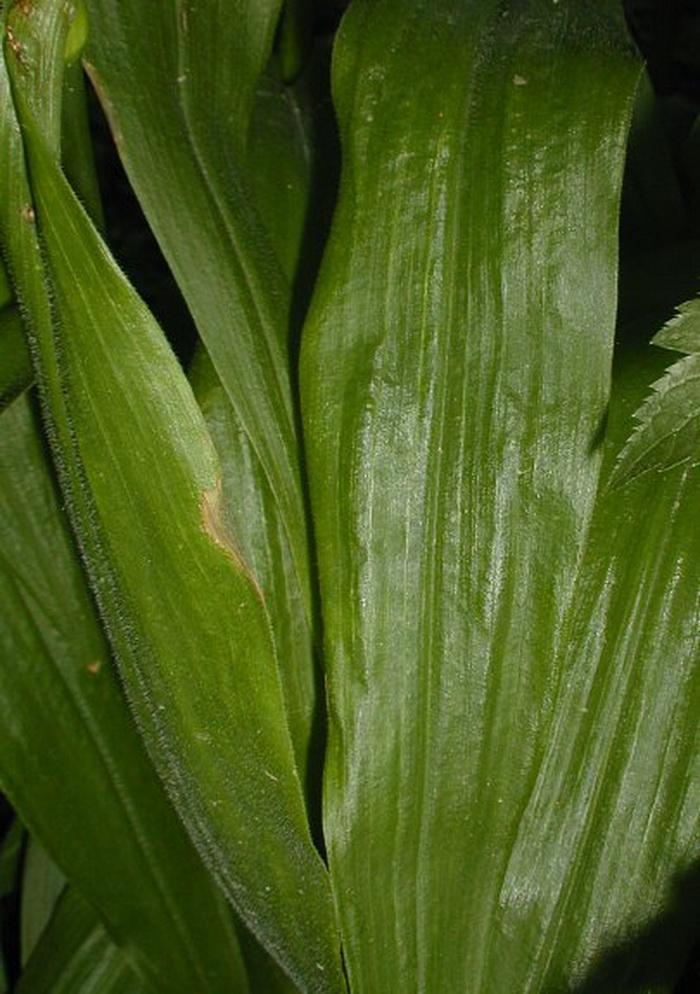
Comments: Of the several spiderwort species (Tradescantia spp.) in Illinois, Zigzag Spiderwort has the broadest leaves (up to 2" across) and they are typically dark green. Other spiderworts within the state have leaves ¾" across or less. Zigzag Spiderwort is better adapted to shady woodland areas than these other species. Another woodland species, Commelina virginica (Virginia Dayflower), has similar leaves, but the petals of its flowers are blue, rather than light violet, and its lower petal is noticeably smaller in size than the upper two. In contrast, the petals of Spiderworts are the same size. Like plant species in the Lily (Liliaceae) and Iris (Iridaceae) families, both spiderworts and dayflowers (Commelina spp.) are monocots, rather than dicots.
Sometimes secondary stems and leaves develop from the axils of the primary leaves. The central stem terminates in a floppy umbel of flowers on slender pedicels. Sometimes umbels of flowers are produced from the axils of the upper leaves or on short secondary stalks. Each flower is about 1" across when it is fully open, consisting of 3 light violet petals (rarely white), 3 medium green sepals, 6 stamens with yellow anthers, and a pistil with a single style. The petals are oval or broadly ovate, while the smaller sepals are ovate and usually hairy. The filaments of the stamens are pale violet; they are densely covered with spidery hairs. The pedicels of the flowers are about ½" long, medium green or reddish purple, and glabrous to hairy. At the base of each umbel of flowers, there is a leafy bract that is opposite from the alternate leaf; this bract is somewhat smaller in size.

The blooming period occurs during the summer, lasting about 1½ months. The flowers are diurnal, opening up during the morning and closing at about noon (although they may remain open longer on cloudy days). Each flower lasts only a single day. Because only a few flowers are in bloom at the same time, the blooming period is fairly long. Afterwards, the flowers are replaced by 3-chambered seed capsules (up to ¼" long); each of these capsules contain several seeds. The seeds are 2-3 mm. long and flattened-ovoid in shape; they have slightly indented centers, from which several fine grooves radiate outward in all directions toward their outer margins. The root system consists of a mass of fleshy fibrous roots, from which clonal offsets are occasionally produced.

Cultivation: The preference is partial sun to medium shade, moist to mesic conditions, and a fertile loamy soil with decaying organic matter. Like other spiderworts (Tradescantia spp.), this plant is little bothered by insect pests and foliar disease. It adapts well to flower gardens in areas where there is some shade.
Range & Habitat: The native Zigzag Spiderwort occurs occasionally in the southern half of Illinois, while it is rare or absent in the northern half of the state (see Distribution Map). Habitats include rich deciduous woodlands, woodland borders, bases of bluffs, bottoms of large ravines, and shaded areas along streams. Sometimes this plant can be found in more disturbed areas, such as shaded areas along railroads, roads, and corners of yards when they are adjacent to woodlands.

Faunal Associations: The flowers are cross-pollinated by bumblebees primarily. Halictid bees, including green metallic bees, collect pollen from the flowers, while Syrphid flies feed on pollen. Insects that feed destructively on Zigzag Spiderwort include the leaf beetles Paratriarius dorsatus, Oulema collaris, and other Oulema spp.; the stink bugs Acrosternum hilaris, Mormidea lugens, Proxys punctulatus, and Euschistus spp.; and the thrips Frankliniella fusca. The mucilaginous foliage of spiderworts (Tradescantia spp.) is eaten occasionally by the Woodland Box Turtle, Cottontail Rabbit, and White-tailed Deer.
Photographic Location: Underneath the shade of a tree in a flower garden at Urbana, Illinois.

Comments: Of the several spiderwort species (Tradescantia spp.) in Illinois, Zigzag Spiderwort has the broadest leaves (up to 2" across) and they are typically dark green. Other spiderworts within the state have leaves ¾" across or less. Zigzag Spiderwort is better adapted to shady woodland areas than these other species. Another woodland species, Commelina virginica (Virginia Dayflower), has similar leaves, but the petals of its flowers are blue, rather than light violet, and its lower petal is noticeably smaller in size than the upper two. In contrast, the petals of Spiderworts are the same size. Like plant species in the Lily (Liliaceae) and Iris (Iridaceae) families, both spiderworts and dayflowers (Commelina spp.) are monocots, rather than dicots.
0
0
文章
Miss Chen
2018年05月25日

Description: This perennial wildflower is about 1-2¼' tall, consisting of loose clumps of unbranched leafy stems that are more or less erect. The central stem of each plant is medium green, slender, terete, and glabrous; it has a pair of longitudinal wings (about 0.5 mm. in length). At intervals, pairs of opposite sessile leaves occur at intervals along each stem. These leaves are 2-4" long and 1-2½" across; they are ovate-cordate, ovate, or lanceolate in shape and their margins are smooth (entire). The upper leaf surface is dark green and glabrous, while the lower leaf surface is medium green and either glabrous or pubescent along the veins. Leaf venation is pinnate; the lateral veins are curved, rather than straight. Above the uppermost pair of leaves, there occurs a spike-like raceme of flowers on a peduncle about 2" long. This raceme is about 1-4" long and curves to one side; about 2-10 flowers occur along the upper side of the raceme, where they are ascending to erect. Each flower is about 1½" long, consisting of a scarlet tubular corolla with 5 upper yellow lobes, a short green calyx with 5 narrow teeth, 5 slightly exerted stamens, and a pistil with a strongly exerted style. The tubular corolla is more narrow toward the bottom than the top; its upper lobes are slightly recurved, widely spreading to ascending, triangular in shape, and about 8-12 mm. in length. The teeth of the calyx are 5-8 mm. long and narrowly linear-lanceolate in shape. The base of the calyx is tubular and very short. The short pedicels of the flowers are up to 2.0 mm. in length.
The blooming period occurs from late spring to early summer (rarely later), lasting about 1 month. There is no noticeable floral scent. Afterwards, the flowers are replaced by 2-celled seed capsules that are 4-6 mm. tall and 6-10 mm. across at maturity. Each cell of the capsule contains a few seeds. Later in the summer, these capsules split open to discharge their seeds explosively. The root system is fibrous and rhizomatous. Clonal offsets often develop from the rhizomes.
Cultivation: The preference is partial sun to light shade, moist conditions, and a fertile loam with abundant organic matter. This plant can be propagated from stem cuttings (dipped in growth hormone) or by division of the root system. Seeds should be planted in the ground as soon as possible. Insect pests and disease organisms rarely bother the foliage. Indian Pink can be cultivated in areas that are north of its natural range (in Zones 4 or 5).
Range & Habitat: The native Indian Pink is occasional in southern Illinois, while in the rest of the state it is absent (see Distribution Map). Illinois lies along the northern range-limit of this species. Habitats include bottomland woodlands, wooded areas along streams, and edges of swamps. This wildflower is found in high quality natural areas.

Faunal Associations: Ruby-throated Hummingbirds cross-pollinate the flowers, from which they receive nectar. Aside from this, little is known about floral-faunal relationships for this species. The foliage and roots of Indian Pink are usually avoided by mammalian herbivores because of their toxicity from alkaloids and calcium oxalate crystals. However, White-tailed Deer may browse on the foliage sparingly in some areas.
Photographic Location: A bottomland woodland in southern Illinois.
Comments: Indian Pink has attractive flowers with striking colors. It is the only member of the Logania family (Loganiaceae) that is native to Illinois. Once the distinctive flowers are in bloom, it is very easy to identify this plant. In the past, the roots of Indian Pink were used as a vermifuge (to expel intestinal worms), however this practice has been largely discontinued because of the potentially dangerous side-effects. Other common names of this plant are Pinkroot and Worm-Grass.
The blooming period occurs from late spring to early summer (rarely later), lasting about 1 month. There is no noticeable floral scent. Afterwards, the flowers are replaced by 2-celled seed capsules that are 4-6 mm. tall and 6-10 mm. across at maturity. Each cell of the capsule contains a few seeds. Later in the summer, these capsules split open to discharge their seeds explosively. The root system is fibrous and rhizomatous. Clonal offsets often develop from the rhizomes.
Cultivation: The preference is partial sun to light shade, moist conditions, and a fertile loam with abundant organic matter. This plant can be propagated from stem cuttings (dipped in growth hormone) or by division of the root system. Seeds should be planted in the ground as soon as possible. Insect pests and disease organisms rarely bother the foliage. Indian Pink can be cultivated in areas that are north of its natural range (in Zones 4 or 5).
Range & Habitat: The native Indian Pink is occasional in southern Illinois, while in the rest of the state it is absent (see Distribution Map). Illinois lies along the northern range-limit of this species. Habitats include bottomland woodlands, wooded areas along streams, and edges of swamps. This wildflower is found in high quality natural areas.

Faunal Associations: Ruby-throated Hummingbirds cross-pollinate the flowers, from which they receive nectar. Aside from this, little is known about floral-faunal relationships for this species. The foliage and roots of Indian Pink are usually avoided by mammalian herbivores because of their toxicity from alkaloids and calcium oxalate crystals. However, White-tailed Deer may browse on the foliage sparingly in some areas.
Photographic Location: A bottomland woodland in southern Illinois.
Comments: Indian Pink has attractive flowers with striking colors. It is the only member of the Logania family (Loganiaceae) that is native to Illinois. Once the distinctive flowers are in bloom, it is very easy to identify this plant. In the past, the roots of Indian Pink were used as a vermifuge (to expel intestinal worms), however this practice has been largely discontinued because of the potentially dangerous side-effects. Other common names of this plant are Pinkroot and Worm-Grass.
0
0
文章
Miss Chen
2018年05月22日

Description: This wildflower consists of a rosette of basal leaves and a flowering stalk about 1-3' tall. Individual basal leaves are up to 9" long and 3" across; they are oblong to ovate-oblong, crenate or smooth along their margins, and medium green. Basal leaves are glabrous to sparsely hairy on their upper surfaces, while their lower surfaces are sparsely to moderately hairy. Generally, young leaves are more hairy than older leaves. The inflorescence consists of a panicle of flowers, which develops from an erect central stalk. This stalk is fairly stout, terete, and densely covered with spreading hairs. The panicle is ellipsoid in shape, ½–1½' long, and about 1/3 as much across when it is fully extended. The branches of the panicle are ascending to spreading and usually pubescent. There is a single linear-lanceolate bract at each major fork of the branches. Depending on the size of the inflorescence, the flowers vary in abundance; they usually bloom at about the same time. Each flower is ¼" across, consisting of 5 narrow white petals, 5 green sepals that are joined together at the base, 10 stamens with white to orange-brown anthers, and 2 prominent pistils that are green and joined together. The sepals are triangular in shape and become recurved when the flowers bloom. The petals are longer than the sepals. The blooming period occurs during the late spring for 2-3 weeks. Each flower is replaced by a pair of beaked follicles; each follicle splits open along one side to release its seeds. The root system consists of a crown of fleshy fibrous roots and rhizomes. Clonal offsets from the rhizomes are often formed.
Cultivation: The preference is light shade to partial sun, consistently moist conditions, high humidity, and thin rocky soil containing sandstone. The site should be protected from prevailing winds.
Range & Habitat: The native Forbe's Saxifrage is found in southern Illinois (where it is uncommon) and 3 counties in northern Illinois, where it is rare; it is absent from the remaining areas of the state (see Distribution Map). This map excludes the distribution of the more common typical variety, Saxifraga pensylvanica pensylvanica (Swamp Saxifrage). Habitats are largely restricted to the lower slopes of rocky bluffs (usually north-facing), moist ledges along sandstone ravines, and the lower slopes of sandstone canyons, particularly where some seepage of moisture occurs. These habitats are always found in wooded areas with varying amounts of shade. Forbe's Saxifrage is restricted to high quality natural areas.
Faunal Associations: The flowers are cross-pollinated primarily by small bees, wasps, and various flies. Less common visitors include sawflies and beetles. These insects usually suck nectar, although some of the bees also collect pollen, while some flies and beetles prefer to feed on the pollen. These observations are from Graenicher.
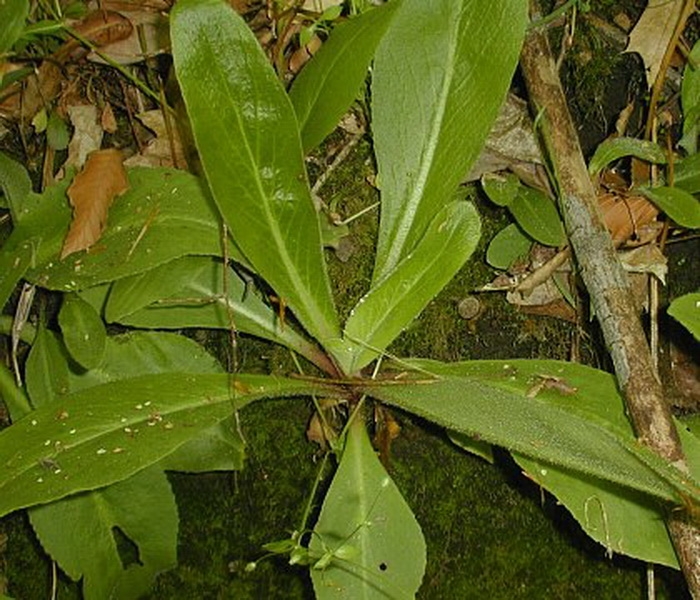
Photographic Location: Lower slope of a sandstone canyon at the Portland Arch in west-central Indiana.
Comments: I have selected Vasey's taxonomic classification of Forbe's Saxifrage. This is something of a compromise. Some botanists in Illinois and Indiana (e.g., Mohlenbrock, 2002) classify Forbe's Saxifrage as a separate species, Saxifraga forbesii, rather than a variety of Saxifraga pensylvanica (Swamp Saxifrage). Other botanists don't recognize Forbe's Saxifrage at even the varietal level. Generally, Forbe's Saxifrage is supposed to have hairier basal leaves than Swamp Saxifrage, and the petals of its flowers are longer than the sepals. Swamp Saxifrage is supposed to have slightly smaller flowers, where the petals are about the same length as the sepals. Swamp Saxifrage is found primarily in the northern half of Illinois, where it is found in both sunny and shaded wetlands. The only other Saxifrage in Illinois is Saxifraga virginiensis (Early Saxifrage), which has been found only in Hardin County. This latter species is much smaller in size; it prefers drier upland areas and can bloom as early as mid-spring.
Cultivation: The preference is light shade to partial sun, consistently moist conditions, high humidity, and thin rocky soil containing sandstone. The site should be protected from prevailing winds.
Range & Habitat: The native Forbe's Saxifrage is found in southern Illinois (where it is uncommon) and 3 counties in northern Illinois, where it is rare; it is absent from the remaining areas of the state (see Distribution Map). This map excludes the distribution of the more common typical variety, Saxifraga pensylvanica pensylvanica (Swamp Saxifrage). Habitats are largely restricted to the lower slopes of rocky bluffs (usually north-facing), moist ledges along sandstone ravines, and the lower slopes of sandstone canyons, particularly where some seepage of moisture occurs. These habitats are always found in wooded areas with varying amounts of shade. Forbe's Saxifrage is restricted to high quality natural areas.
Faunal Associations: The flowers are cross-pollinated primarily by small bees, wasps, and various flies. Less common visitors include sawflies and beetles. These insects usually suck nectar, although some of the bees also collect pollen, while some flies and beetles prefer to feed on the pollen. These observations are from Graenicher.

Photographic Location: Lower slope of a sandstone canyon at the Portland Arch in west-central Indiana.
Comments: I have selected Vasey's taxonomic classification of Forbe's Saxifrage. This is something of a compromise. Some botanists in Illinois and Indiana (e.g., Mohlenbrock, 2002) classify Forbe's Saxifrage as a separate species, Saxifraga forbesii, rather than a variety of Saxifraga pensylvanica (Swamp Saxifrage). Other botanists don't recognize Forbe's Saxifrage at even the varietal level. Generally, Forbe's Saxifrage is supposed to have hairier basal leaves than Swamp Saxifrage, and the petals of its flowers are longer than the sepals. Swamp Saxifrage is supposed to have slightly smaller flowers, where the petals are about the same length as the sepals. Swamp Saxifrage is found primarily in the northern half of Illinois, where it is found in both sunny and shaded wetlands. The only other Saxifrage in Illinois is Saxifraga virginiensis (Early Saxifrage), which has been found only in Hardin County. This latter species is much smaller in size; it prefers drier upland areas and can bloom as early as mid-spring.
0
0
文章
Miss Chen
2018年05月17日

Description: This herbaceous perennial plant is about 2-4' tall and either branched or unbranched. The stems are light to medium green and abundantly covered with stiff white hairs that have the capacity to sting when they are rubbed against. The lower to middle leaves are alternate, while the upper leaves are opposite. These leaves are up to 6" long and 4" across; they are medium to dark green, ovate-cordate to oval-ovate in shape, and coarsely serrated or serrated-crenate. Young leaves are densely hairy and wrinkled in appearance, while older leaves become less hairy and wrinkled with age. Leaf venation is pinnate. The petioles are up to 4" long and abundantly covered with stinging hairs, like the stems. The leaves may have a few stinging hairs as well, particularly along the central veins of their undersides. Some plants have a tendency to loose many of their stinging hairs as the season progresses. Individual plants are either monoecious (separate male and female flowers on the same plant) or unisexual.
The male flowers occur in branching cymes from the axils of the leaves. These cymes spread outward from the stem and they are about the same length as the petioles of the leaves. Each male flower is greenish white to white and less than 1/8" (3 mm.) across, consisting of 5 narrow sepals, 5 stamens, and no petals. The female flowers occur in branching cymes toward the apex of the plant. These cymes are erect to spreading and 4" or more in length. Each female flower is more or less green and about 1/8" (3 mm.) across, consisting of 4 sepals of unequal size (2 large and 2 small) and an ovary with a long style. The blooming period usually occurs during mid- to late summer. The flowers are wind-pollinated. Each female flower is replaced by a small dry fruit that is curved and ovoid in shape. This plant often forms colonies of variable size.
Cultivation: The preference is partial sun to medium shade, moist conditions, and a fertile loamy soil with abundant organic matter. Because of its stinging hairs and tendency to spread, you probably would not want to cultivate this plant near the house, except possibly as a privacy barrier.
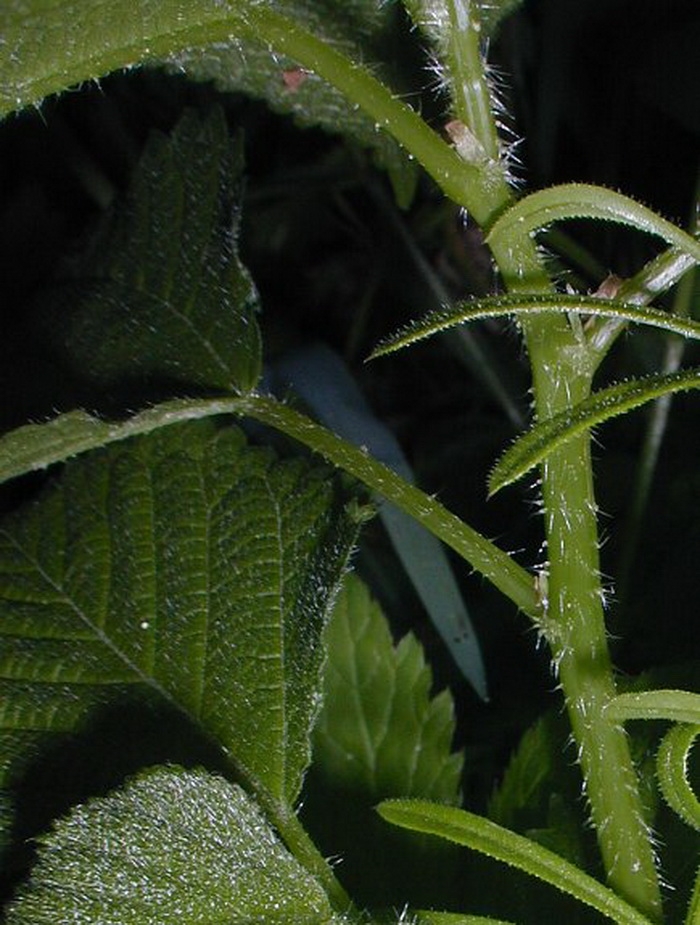
Range & Habitat: The native Wood Nettle is common in central and northern Illinois, but it is uncommon or absent in parts of southern Illinois (see Distribution Map). Habitats include moist floodplain woodlands, moist bottomland woodlands, mesic woodlands, shady seeps, and other moist places in wooded areas. Various deciduous trees (e.g., elms, maples, or sycamore) dominate the habitats where the Wood Nettle occurs.
Faunal Associations: The caterpillars of the following butterflies feed on the foliage: Polygonia comma (Comma), Polygonia interrogationis (Question Mark), and Vanessa atalanta (Red Admiral). Other insect feeders include caterpillars of the moths Bomolocha edictalis (Large Bomolocha) and Bomolocha sordidula (Sordid Bomolocha), leaf-mining larvae of the fly Agromyza subnigripes, and the stink bug Proxys punctulatus. White-tailed Deer also browse on the foliage of Wood Nettle occasionally, notwithstanding the stinging hairs. When this plant forms dense colonies in wooded areas, it provides valuable cover for wildlife.

Photographic Location: A floodplain woodland in Vermilion County, Illinois. The Wood Nettle in the photographs wasn't in bloom.
Comments: This native plant is often mistaken for the introduced Urtica dioica (Stinging Nettle). Both species have stinging hairs and a similar appearance. However, the Wood Nettle has some alternate leaves, while Stinging Nettle has pairs of opposite leaves only. There are also differences in the characteristics of their flowers. Another similar species, Boehmeria cylindrica (False Nettle), also has opposite leaves, but it lacks stinging hairs altogether. Like other members of the Nettle family, the Wood Nettle lacks showy flowers because they are wind-pollinated, rather than pollinated by insects. Some people may regard this species as an undesirable woodland weed because of its stinging hairs and unassuming appearance, but it is an important host plant of some native butterflies.
The male flowers occur in branching cymes from the axils of the leaves. These cymes spread outward from the stem and they are about the same length as the petioles of the leaves. Each male flower is greenish white to white and less than 1/8" (3 mm.) across, consisting of 5 narrow sepals, 5 stamens, and no petals. The female flowers occur in branching cymes toward the apex of the plant. These cymes are erect to spreading and 4" or more in length. Each female flower is more or less green and about 1/8" (3 mm.) across, consisting of 4 sepals of unequal size (2 large and 2 small) and an ovary with a long style. The blooming period usually occurs during mid- to late summer. The flowers are wind-pollinated. Each female flower is replaced by a small dry fruit that is curved and ovoid in shape. This plant often forms colonies of variable size.
Cultivation: The preference is partial sun to medium shade, moist conditions, and a fertile loamy soil with abundant organic matter. Because of its stinging hairs and tendency to spread, you probably would not want to cultivate this plant near the house, except possibly as a privacy barrier.

Range & Habitat: The native Wood Nettle is common in central and northern Illinois, but it is uncommon or absent in parts of southern Illinois (see Distribution Map). Habitats include moist floodplain woodlands, moist bottomland woodlands, mesic woodlands, shady seeps, and other moist places in wooded areas. Various deciduous trees (e.g., elms, maples, or sycamore) dominate the habitats where the Wood Nettle occurs.
Faunal Associations: The caterpillars of the following butterflies feed on the foliage: Polygonia comma (Comma), Polygonia interrogationis (Question Mark), and Vanessa atalanta (Red Admiral). Other insect feeders include caterpillars of the moths Bomolocha edictalis (Large Bomolocha) and Bomolocha sordidula (Sordid Bomolocha), leaf-mining larvae of the fly Agromyza subnigripes, and the stink bug Proxys punctulatus. White-tailed Deer also browse on the foliage of Wood Nettle occasionally, notwithstanding the stinging hairs. When this plant forms dense colonies in wooded areas, it provides valuable cover for wildlife.

Photographic Location: A floodplain woodland in Vermilion County, Illinois. The Wood Nettle in the photographs wasn't in bloom.
Comments: This native plant is often mistaken for the introduced Urtica dioica (Stinging Nettle). Both species have stinging hairs and a similar appearance. However, the Wood Nettle has some alternate leaves, while Stinging Nettle has pairs of opposite leaves only. There are also differences in the characteristics of their flowers. Another similar species, Boehmeria cylindrica (False Nettle), also has opposite leaves, but it lacks stinging hairs altogether. Like other members of the Nettle family, the Wood Nettle lacks showy flowers because they are wind-pollinated, rather than pollinated by insects. Some people may regard this species as an undesirable woodland weed because of its stinging hairs and unassuming appearance, but it is an important host plant of some native butterflies.
0
0
文章
Miss Chen
2018年05月07日

Description: This perennial wildflower is 1½–3' tall and usually unbranched. The central stem is hairy. The alternate leaves are up to 6" long and 1½" across; they are medium to dark green and elliptic in shape. The leaf margins are smooth and ciliate; on rare occasions, a few teeth may occur along the outer margins. Each leaf tapers gradually to a wedge-shaped base and a short petiole. The upper and lower surfaces of each leaf are hairless to somewhat hairy. At the upper axil of each leaf, there are 1-3 small nodding flowers that are light green. Each flower is about ¼" long, consisting of 5 linear sepals, 5 oblong petals, 5 stamens, and a pistil. The pedicel of each flower is about ½" long and hairy. Near the base of each pedicel, there is a pair of linear stipules (leafy bracts) up to ¼" long. Terminal flowers are not produced.
The blooming period occurs from mid-spring to early summer and lasts about 1–1½ months. There is no noticeable floral scent. Each fertile flower is replaced by a seed capsule about ½–¾" long. The seed capsules are light green, ovoid-oblongoid in shape, and hairless. At maturity, each capsule splits into 3 sections to release the seeds. The root system is is fibrous and rhizomatous. Clonal colonies of plants are occasionally formed from the rhizomes.
Cultivation: The preference is dappled sunlight to medium shade, moist to mesic conditions, and a rich loamy soil with abundant organic matter (e.g., fallen leaves). Some rocky material (e.g., limestone) is also tolerated. The pH of the soil should be mildly acid, neutral, or basic.
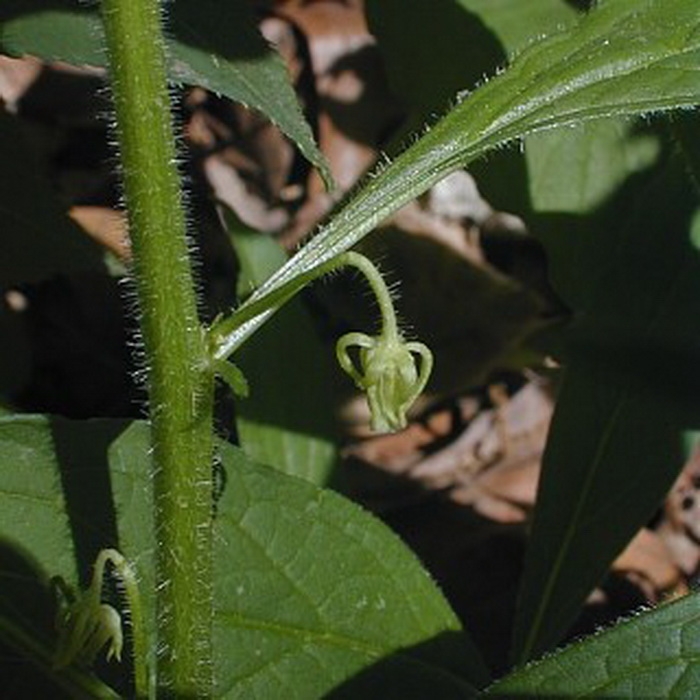
Range & Habitat: The native Green Violet is occasional in most areas of Illinois, except in the NW section, where it is absent (see Distribution Map). Overall, it is more common in hilly areas of southern Illinois than in the glaciated areas of northern Illinois. Habitats include moist to mesic deciduous woodlands, wooded slopes, shaded terraces along streams, and damp ravines, particularly where calcareous rocky material is close to the surface of the ground. This species is fairly conservative and normally found in high quality woodlands where the original ground flora is still intact.
Faunal Associations: Very little is known about floral-faunal relationships for this species. Robertson observed a green metallic bee, Augochlorella striata, sucking nectar from the flowers; however, insect visitors to the non-showy flowers are uncommon. The polyphagous insect, Acrosternum hilaris (Green Stink Bug; a.k.a. Chinavia hilare) sucks juices from the foliage. White-Tailed Deer often chomp off the tops of this plant. It is possible that upland gamebirds and the White-Footed Mouse feed on the seeds, which are rather large in size.

Photographic Location: A shaded ravine in Vermilion County, Illinois.
Comments: This atypical member of the Violet family is primarily a foliage plant; the small flowers are largely hidden by the leaves and non-showy. The seed capsules of Green Violet are very similar in appearance to those of other violets (Viola spp.), although they are somewhat larger in size; the seed capsules of both the Green Violet and other violets divide into 3 longitudinal sections to release their seeds. There is also some similarity in the structure of their respective flowers. Looking at this plant, most people would never guess that it is a violet.
The blooming period occurs from mid-spring to early summer and lasts about 1–1½ months. There is no noticeable floral scent. Each fertile flower is replaced by a seed capsule about ½–¾" long. The seed capsules are light green, ovoid-oblongoid in shape, and hairless. At maturity, each capsule splits into 3 sections to release the seeds. The root system is is fibrous and rhizomatous. Clonal colonies of plants are occasionally formed from the rhizomes.
Cultivation: The preference is dappled sunlight to medium shade, moist to mesic conditions, and a rich loamy soil with abundant organic matter (e.g., fallen leaves). Some rocky material (e.g., limestone) is also tolerated. The pH of the soil should be mildly acid, neutral, or basic.

Range & Habitat: The native Green Violet is occasional in most areas of Illinois, except in the NW section, where it is absent (see Distribution Map). Overall, it is more common in hilly areas of southern Illinois than in the glaciated areas of northern Illinois. Habitats include moist to mesic deciduous woodlands, wooded slopes, shaded terraces along streams, and damp ravines, particularly where calcareous rocky material is close to the surface of the ground. This species is fairly conservative and normally found in high quality woodlands where the original ground flora is still intact.
Faunal Associations: Very little is known about floral-faunal relationships for this species. Robertson observed a green metallic bee, Augochlorella striata, sucking nectar from the flowers; however, insect visitors to the non-showy flowers are uncommon. The polyphagous insect, Acrosternum hilaris (Green Stink Bug; a.k.a. Chinavia hilare) sucks juices from the foliage. White-Tailed Deer often chomp off the tops of this plant. It is possible that upland gamebirds and the White-Footed Mouse feed on the seeds, which are rather large in size.

Photographic Location: A shaded ravine in Vermilion County, Illinois.
Comments: This atypical member of the Violet family is primarily a foliage plant; the small flowers are largely hidden by the leaves and non-showy. The seed capsules of Green Violet are very similar in appearance to those of other violets (Viola spp.), although they are somewhat larger in size; the seed capsules of both the Green Violet and other violets divide into 3 longitudinal sections to release their seeds. There is also some similarity in the structure of their respective flowers. Looking at this plant, most people would never guess that it is a violet.
0
0
文章
Miss Chen
2018年05月06日

Description: This wildflower is a winter annual about 4-12" tall that is unbranched. The central stem is light green, terete, and pubescent. The opposite leaves are up to 2" long and ¾" across; they are either medium green or yellowish green and either glabrous or pubescent (usually the latter). The lowest leaves are oval to orbicular with a few blunt teeth along their margins; they are smaller than the other leaves and there are petioles at their bases. The middle leaves are the largest and most conspicuous; they are oval to broadly lanceolate, often with a few blunt teeth along their margins, and their bases are either sessile or they clasp the stem. The uppermost leaves are usually lanceolate and smooth along their margins; their bases are either sessile or they clasp the stem.
The central stem terminates in a whorl of 2-6 flowers on slender pedicels up to 1" long. Sometimes individual flowers develop from the axils of the upper leaves as well; these axillary flowers have slender pedicels up to 1½" long. The pedicels are light green, terete, and pubescent. Each flower is ½-¾" across, consisting of a green calyx with 5 teeth and a blue/white corolla. The calyx is light green to purplish green; it is often pubescent and its teeth are narrowly triangular in shape. The corolla is short-tubular and it is divided into upper and lower lips. The upper lip is cleft into 2 large rounded lobes that are white, while the lower lip is cleft into 3 lobes. The 2 large outer lobes of the lower lip are light blue to blue-violet and rounded, while the tiny middle lobe of the lower lip is folded into a keel and hidden from view. This middle lobe contains the stamens and style of the flower.
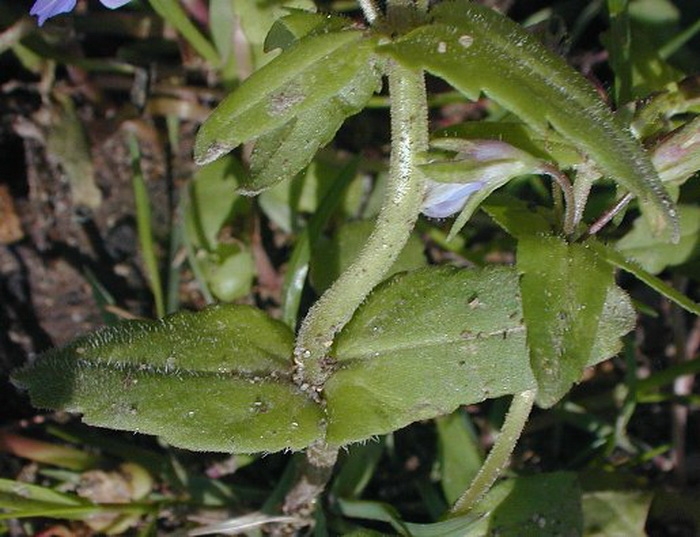
The blooming period occurs from mid- to late spring, lasting about 3 weeks. Afterwards, each flower is replaced by an globoid-ovoid capsule that contains a few large seeds. The root system consists of a slender taproot. This plant spreads by reseeding itself; it often forms colonies of variable size.
Cultivation: The preference is dappled sunlight to light shade, moist to mesic conditions, and a rich loamy soil. The size of individual plants is strongly influenced by moisture conditions and the fertility of the soil. The seeds should be planted during the summer so that they will germinate during the fall.
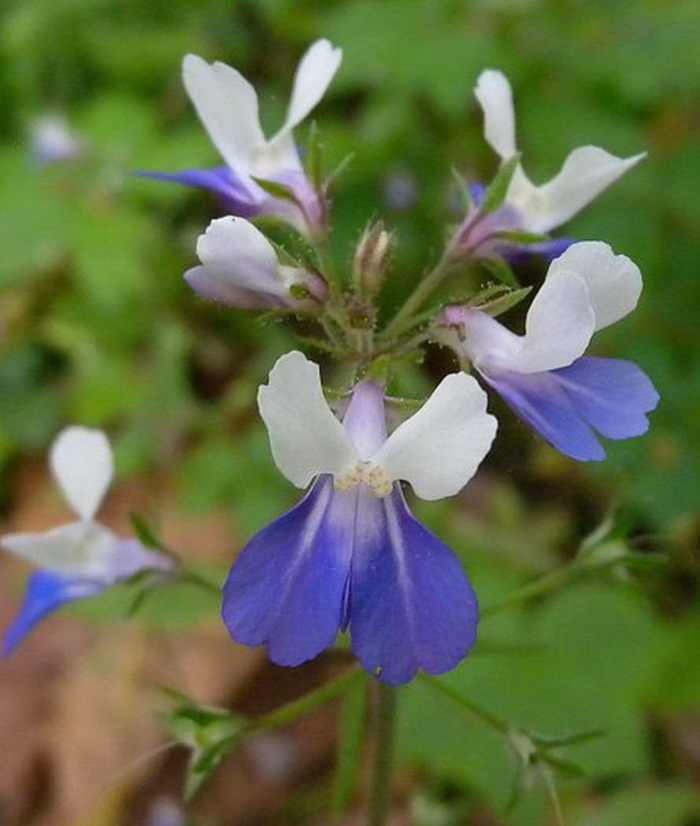
Range & Habitat: Blue-Eyed Mary occurs occasionally in NE and east central Illinois, but it tends to be less common elsewhere (see Distribution Map). At some high quality sites around the state, it is locally abundant. Habitats include moist to mesic deciduous woodlands, wooded lower slopes of river valleys, and areas along woodland paths. Sometimes Blue-Eyed Mary occurs in drier deciduous woodlands, in which case the individual plants will be smaller in size. Even though it tolerates minor levels of disturbance, this wildflower is an indicator species of high quality woodlands.
Faunal Associations: The nectar and pollen of the flowers attract honeybees, bumblebees, little carpenter bees (Ceratina spp.), long-horned bees (Synhalonia spp.), and mason bees (Osmia spp.). Less common flower visitors include dance flies (Empis spp.), the Giant Bee Fly (Bombylius major), butterflies, and skippers. Little else appears to be known about floral-faunal relationships for this species.

Photographic Location: Along a path in a deciduous woodlands at Allerton Park in Piatt County, Illinois, and the wooded lower slope of a river valley at Lodge Park in the same county.
Comments: The distinctive bicolored flowers are very beautiful, making Blue-Eyed Mary easy to identify. This woodland wildflower is unusual in having flowers that are close to a true blue color. The only other species in the genus that has been observed in Illinois is Collinsia violacea (Violet Collinsia). This latter wildflower is also a winter annual that has corollas with a deeper shade of purplish violet and more narrow lanceolate leaves. Violet Collinsia prefers sunnier habitats than Blue-Eyed Mary, and it is quite rare within the state, although more common in the Southern Plains region of the United States.
The central stem terminates in a whorl of 2-6 flowers on slender pedicels up to 1" long. Sometimes individual flowers develop from the axils of the upper leaves as well; these axillary flowers have slender pedicels up to 1½" long. The pedicels are light green, terete, and pubescent. Each flower is ½-¾" across, consisting of a green calyx with 5 teeth and a blue/white corolla. The calyx is light green to purplish green; it is often pubescent and its teeth are narrowly triangular in shape. The corolla is short-tubular and it is divided into upper and lower lips. The upper lip is cleft into 2 large rounded lobes that are white, while the lower lip is cleft into 3 lobes. The 2 large outer lobes of the lower lip are light blue to blue-violet and rounded, while the tiny middle lobe of the lower lip is folded into a keel and hidden from view. This middle lobe contains the stamens and style of the flower.

The blooming period occurs from mid- to late spring, lasting about 3 weeks. Afterwards, each flower is replaced by an globoid-ovoid capsule that contains a few large seeds. The root system consists of a slender taproot. This plant spreads by reseeding itself; it often forms colonies of variable size.
Cultivation: The preference is dappled sunlight to light shade, moist to mesic conditions, and a rich loamy soil. The size of individual plants is strongly influenced by moisture conditions and the fertility of the soil. The seeds should be planted during the summer so that they will germinate during the fall.

Range & Habitat: Blue-Eyed Mary occurs occasionally in NE and east central Illinois, but it tends to be less common elsewhere (see Distribution Map). At some high quality sites around the state, it is locally abundant. Habitats include moist to mesic deciduous woodlands, wooded lower slopes of river valleys, and areas along woodland paths. Sometimes Blue-Eyed Mary occurs in drier deciduous woodlands, in which case the individual plants will be smaller in size. Even though it tolerates minor levels of disturbance, this wildflower is an indicator species of high quality woodlands.
Faunal Associations: The nectar and pollen of the flowers attract honeybees, bumblebees, little carpenter bees (Ceratina spp.), long-horned bees (Synhalonia spp.), and mason bees (Osmia spp.). Less common flower visitors include dance flies (Empis spp.), the Giant Bee Fly (Bombylius major), butterflies, and skippers. Little else appears to be known about floral-faunal relationships for this species.

Photographic Location: Along a path in a deciduous woodlands at Allerton Park in Piatt County, Illinois, and the wooded lower slope of a river valley at Lodge Park in the same county.
Comments: The distinctive bicolored flowers are very beautiful, making Blue-Eyed Mary easy to identify. This woodland wildflower is unusual in having flowers that are close to a true blue color. The only other species in the genus that has been observed in Illinois is Collinsia violacea (Violet Collinsia). This latter wildflower is also a winter annual that has corollas with a deeper shade of purplish violet and more narrow lanceolate leaves. Violet Collinsia prefers sunnier habitats than Blue-Eyed Mary, and it is quite rare within the state, although more common in the Southern Plains region of the United States.
1
0
文章
Miss Chen
2018年05月05日

Description: This annual plant is about ½–4' tall. Medium to large plants (greater than 1½' tall) branch occasionally, while small plants (less than 1½' tall) are often unbranched. The central and lateral stems are hairless. Alternate leaves are up to 6" long and 4" across; they are ovate or deltoid-ovate with 2-4 large teeth along their margins. These teeth are pointed and widely spaced. The uppermost leaves are moreFlowering Plants narrow and may have only 0-1 teeth along their margins. The widely spreading leaves are medium to dark green and hairless; they are not white-mealy on their undersides. The leaf tips are pointed, while their bases are truncate or slightly indented. The slender petioles are up to 1" long. The central stem and upper lateral stems terminate in panicles of sessile clustered flowers. In addition to these, there are usually secondary panicles that develop from the axils of the upper leaves. The branches of these panicles can be hairless or conspicuously hairy. Individual flowers are green or greenish white and only 1/8" (3 mm.) across, consisting of 5 sepals, 5 stamens, and a flattened ovary with a pair of tiny styles at its apex. There are no petals. The sepals are ovate and slightly keeled. The blooming period can occur from late spring into the fall. On an individual plant in bloom, the flowers are at different stages of development. Pollination is by wind. The persistent sepals only partially cover the developing seeds; there is only one seed per flower. Each seed is covered with a thin membrane that is easily removed. Individual seeds are flattened, circular in circumference, and shiny black; they are 1.5–2.0 mm. across. The root system consists of a taproot. This plant spreads into new areas by reseeding itself.
Cultivation: The preference is dappled sunlight to medium shade and mesic to dry conditions. While this plant is usually found on rocky ground, it will adapt to ordinary garden soil. Depending on the fertility of the soil and moisture conditions, the size of individual plants can vary considerably.
Range & Habitat: Maple-Leaved Goosefoot is uncommon to occasional in most areas of Illinois, except in the east-central section of the state, where it is rare or absent (see Distribution Map). This is a native plant. Habitats include rocky upland woodlands, shaded or semi-shaded ledges of cliffs, bottoms of thinly wooded bluffs, recently logged or burned woodlands, woodland openings, shaded to semi-shaded areas of rocky glades, thickets, and fence rows. Maple-Leaved Goosefoot is often found in high quality habitats, but it also occurs in disturbed areas. This is one of the less weedy Chenopodium spp.
Faunal Associations: Little is known about floral-faunal relationships for this unusual woodland plant, although several moths, skippers, and leaf beetles are known to feed on Chenopodium spp. primarily in weedy open areas. The Bobwhite and several sparrows eat the seeds of these species, while White-Tailed Deer occasionally browse on the foliage.

Photographic Location: Ledge of a sandstone cliff at the Portland Arch in west-central Indiana.
Comments: Maple-Leaved Goosefoot (Chenopodium simplex) has very distinctive leaves, which makes it is easy to recognize. These leaves are usually larger in size than those of many other Chenopodium spp., and they usually have 1-4 pairs of widely spaced large teeth. Other Chenopodium spp. have leaves with smaller teeth or their leaves lack teeth altogether. Unlike Maple-Leaved Goosefoot, these latter species often have white-mealy leaf undersides, white-mealy upper stems, and/or white-mealy sepals. They are usually found in sunny disturbed areas rather than woodlands. The American species, Maple-Leaved Goosefoot (Chenopodium simplex), closely resembles a European species with the same common name, Chenopodium hybridum (Maple-Leaved Goosefoot), but it has a different number of chromosomes. The American species is sometimes referred to as Chenopodium gigantospermum, which refers to its relatively large seeds for species in this genus.
Cultivation: The preference is dappled sunlight to medium shade and mesic to dry conditions. While this plant is usually found on rocky ground, it will adapt to ordinary garden soil. Depending on the fertility of the soil and moisture conditions, the size of individual plants can vary considerably.
Range & Habitat: Maple-Leaved Goosefoot is uncommon to occasional in most areas of Illinois, except in the east-central section of the state, where it is rare or absent (see Distribution Map). This is a native plant. Habitats include rocky upland woodlands, shaded or semi-shaded ledges of cliffs, bottoms of thinly wooded bluffs, recently logged or burned woodlands, woodland openings, shaded to semi-shaded areas of rocky glades, thickets, and fence rows. Maple-Leaved Goosefoot is often found in high quality habitats, but it also occurs in disturbed areas. This is one of the less weedy Chenopodium spp.
Faunal Associations: Little is known about floral-faunal relationships for this unusual woodland plant, although several moths, skippers, and leaf beetles are known to feed on Chenopodium spp. primarily in weedy open areas. The Bobwhite and several sparrows eat the seeds of these species, while White-Tailed Deer occasionally browse on the foliage.

Photographic Location: Ledge of a sandstone cliff at the Portland Arch in west-central Indiana.
Comments: Maple-Leaved Goosefoot (Chenopodium simplex) has very distinctive leaves, which makes it is easy to recognize. These leaves are usually larger in size than those of many other Chenopodium spp., and they usually have 1-4 pairs of widely spaced large teeth. Other Chenopodium spp. have leaves with smaller teeth or their leaves lack teeth altogether. Unlike Maple-Leaved Goosefoot, these latter species often have white-mealy leaf undersides, white-mealy upper stems, and/or white-mealy sepals. They are usually found in sunny disturbed areas rather than woodlands. The American species, Maple-Leaved Goosefoot (Chenopodium simplex), closely resembles a European species with the same common name, Chenopodium hybridum (Maple-Leaved Goosefoot), but it has a different number of chromosomes. The American species is sometimes referred to as Chenopodium gigantospermum, which refers to its relatively large seeds for species in this genus.
0
0
文章
Miss Chen
2018年05月04日

Description: This perennial wildflower is ½–1½' tall with an erect stem that is unbranched or sparingly branched toward the apex where the inflorescence occurs. The central stem is medium green, glabrous, and terete; it occasionally has fine longitudinal ridges. There are both basal leaves and alternate leaves. The blades of the basal leaves are up to 1¼" long and 1" across; they are oval to orbicular in shape,Raceme of Flowers medium green, glabrous, and smooth or undulate along their margins. The slender petioles of the basal leaves are usually longer than the blades. The alternate leaves are produced sparingly along the central stem; they are up to 2" long and 1" across, medium green, and glabrous. The alternate leaves are oblong-ovate in shape and their margins are smooth, undulate, or bluntly dentate; at the base, each alternate leaf is sessile or short-petioled. The central stem terminates in a raceme of flowers; the flowers usually bloom in the upper half of the raceme, while their siliques (narrowly cylindrical seedpods) develop below. Each flower consists of 4 petals, 4 sepals, 6 stamens, and a pistil with a single style; when the flower is fully open, it spans about ½" across. The petals are white with rounded tips. The glabrous sepals are initially green, but they become yellow as they age. The petals are much longer than the sepals. Each flower has a slender pedicel about ½" long. The blooming period occurs from mid- to late spring and lasts about 3 weeks. The flowers are sometimes fragrant. Each flower is replaced by a slender hairless silique about 1" long that is somewhat flattened. The siliques are ascending to erect; they eventually divide into two parts to release their seeds. These seeds are ovoid, somewhat flattened, and wingless; they are arranged in a single row in each silique. Each plant has a swollen tuberous rootstock at the base of the central stem; this tuberous rootstock has spreading fibrous roots that occasionally produce small tubers. New plants are created from either the seeds or tubers.
Cultivation: The preference is partial sun or dappled sunlight, wet to moist conditions, and a loose fertile loam with organic material. Shallow standing water is tolerated if it is temporary; full sun is tolerated if the ground is consistently moist. Most growth and development occurs during the spring before the canopy trees leaf out.
Range & Habitat: The native Spring Cress is occasional to locally common in most areas of Illinois; it is less common or absent in the SW section of the state (see Distribution Map). This species may be less common than in the past. Habitats include low woodlands along rivers, edges of vernal pools in woodlands, damp depressions in rocky bluffs, woodland seeps and springs, and damp meadows.
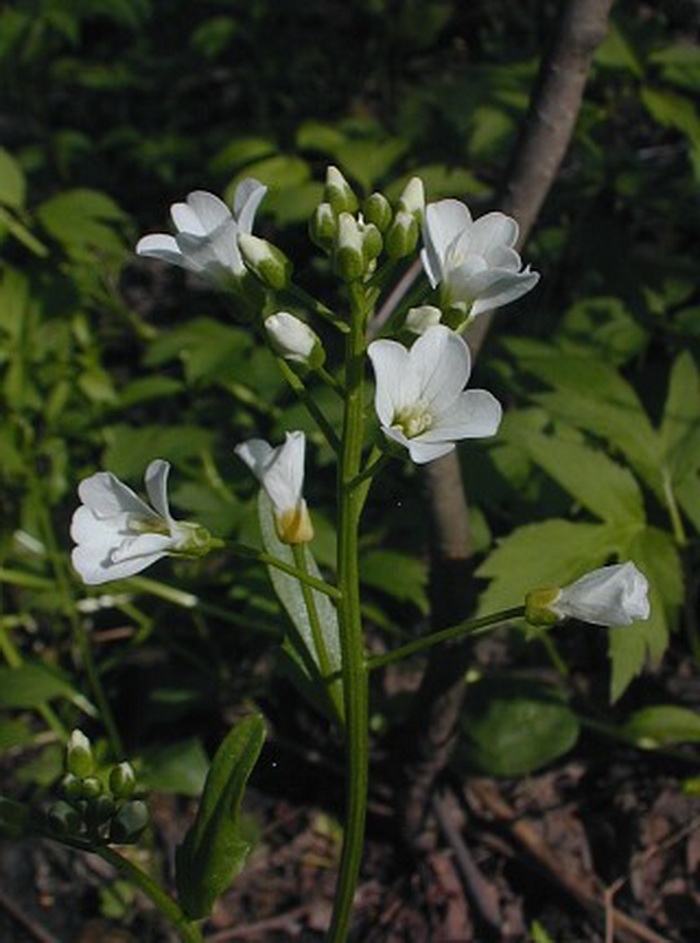
Faunal Associations: The nectar of the flowers attracts cuckoo bees (Nomada spp.), mason bees (Osmia spp.), little carpenter bees (Ceratina spp.), Halictid bees (Augochlorella spp., Halictus spp., & Lasioglossum spp.), Andrenid bees (Andrena spp.), bee flies (Bombylius spp.), dance flies (Empis spp.), Syrphid flies (miscellaneous), small- to medium-sized butterflies (miscellaneous), and skippers (miscellaneous). Some of the bees also collect pollen. The flea beetles Phyllotreta oblonga and Phyllotreta bipustulata feed on Spring Cress and other Cardamine spp. (Bitter Cress species). Mammalian herbivores usually avoid the consumption of Spring Cress because its foliage is pungent and somewhat bitter.
Photographic Location: A low woodland along the Sangamon river in Piatt County, Illinois.
Comments: Spring Cress is one of the more attractive members of the Mustard family as its flowers are fairly large (spanning about ½" across). This wildflower favors the more damp areas of woodlands and it is sometimes found in soggy meadows. Another native species, Cardamine douglassii (Purple Cress), is very similar to Spring Cress. Both species prefer similar habitats, bloom during the spring, and their flowers and foliage are similar to each other. Purple Cress differs from Spring Cress by the purplish-pink tint of its flower petals, sepals that are dark purple and hairy, and stems that are hairy toward the base. It has a tendency to bloom about 2 weeks before Spring Cress. Other Cardamine spp. (Bitter Cress species) in Illinois have either smaller flowers (about ¼" across or less) or at least some of their leaves are deeply divided into lobes (either pinnately or palmately). Spring Cress (and other species in the genus) isn't classified as an Arabis sp. (Rock Cress) because of its wingless seeds; the seeds of Rock Cresses have winged membranous margins of varying widths.
Cultivation: The preference is partial sun or dappled sunlight, wet to moist conditions, and a loose fertile loam with organic material. Shallow standing water is tolerated if it is temporary; full sun is tolerated if the ground is consistently moist. Most growth and development occurs during the spring before the canopy trees leaf out.
Range & Habitat: The native Spring Cress is occasional to locally common in most areas of Illinois; it is less common or absent in the SW section of the state (see Distribution Map). This species may be less common than in the past. Habitats include low woodlands along rivers, edges of vernal pools in woodlands, damp depressions in rocky bluffs, woodland seeps and springs, and damp meadows.

Faunal Associations: The nectar of the flowers attracts cuckoo bees (Nomada spp.), mason bees (Osmia spp.), little carpenter bees (Ceratina spp.), Halictid bees (Augochlorella spp., Halictus spp., & Lasioglossum spp.), Andrenid bees (Andrena spp.), bee flies (Bombylius spp.), dance flies (Empis spp.), Syrphid flies (miscellaneous), small- to medium-sized butterflies (miscellaneous), and skippers (miscellaneous). Some of the bees also collect pollen. The flea beetles Phyllotreta oblonga and Phyllotreta bipustulata feed on Spring Cress and other Cardamine spp. (Bitter Cress species). Mammalian herbivores usually avoid the consumption of Spring Cress because its foliage is pungent and somewhat bitter.
Photographic Location: A low woodland along the Sangamon river in Piatt County, Illinois.
Comments: Spring Cress is one of the more attractive members of the Mustard family as its flowers are fairly large (spanning about ½" across). This wildflower favors the more damp areas of woodlands and it is sometimes found in soggy meadows. Another native species, Cardamine douglassii (Purple Cress), is very similar to Spring Cress. Both species prefer similar habitats, bloom during the spring, and their flowers and foliage are similar to each other. Purple Cress differs from Spring Cress by the purplish-pink tint of its flower petals, sepals that are dark purple and hairy, and stems that are hairy toward the base. It has a tendency to bloom about 2 weeks before Spring Cress. Other Cardamine spp. (Bitter Cress species) in Illinois have either smaller flowers (about ¼" across or less) or at least some of their leaves are deeply divided into lobes (either pinnately or palmately). Spring Cress (and other species in the genus) isn't classified as an Arabis sp. (Rock Cress) because of its wingless seeds; the seeds of Rock Cresses have winged membranous margins of varying widths.
0
0
文章
Miss Chen
2018年05月01日

Description: This herbaceous perennial plant produces basal leaves 4-9" long and 1½-3½" across on short petioles (usually 2-3 per bulb). The basal leaves are ovate-oval to ovate-elliptic, light to medium green, hairless, and smooth along the margins. Their petioles are reddish, hairless, and wrapped in a basal sheath below. These leaves develop during the spring and wither away by early summer. During early to mid-summer, there develops a naked flowering stalk about ½-1½' tall. This stalk is terete, glabrous, and reddish to pale green; at its base, there is a papery sheath. The stalk terminates in a single rounded umbel of flowers spanning 1-2" across; there are typically 20-40 flowers per umbel. At the base of this umbel, there is a pair of deciduous bracts. Each flower is about ¼" across, consisting of 6 white to translucent white tepals, a light green to pale yellow ovary, 6 stamens with pale yellow anthers, and a single white style. At the base of each flower, there is a slender pedicel that is white to greenish white. The blooming period occurs during the summer and lasts about 2 weeks. Both the flowers and foliage exude an onion-like odor. After the blooming period, the ovary of each flower matures into a 3-celled seed capsule; each cell contains a single globoid seed that becomes black at maturity. The root system consists of an ovoid bulb with fibrous roots at its base. Offsets often develop, producing clonal colonies of plants.
Cultivation: The preference is dappled sunlight during the spring when the basal leaves develop, while during the summer considerable shade is tolerated as the basal leaves have withered away. The soil should consist of a rich loose loam with abundant organic matter, while moisture levels should be more or less mesic. It is easiest to introduce new plants into an area by dividing and transplanting the bulbs during the fall.
Range & Habitat: The native Wild Leek occurs occasionally in central and northern Illinois, while in the southern section of the state it is rare or absent (see Distribution Map). Habitats include mesic deciduous woodlands and wooded bluffs. The presence of this species is a sign that the original flora of a woodlands is still in intact. An introduced species, Alliaria petiolata (Garlic Mustard), can shade out the basal leaves of Wild Leek during the spring, causing the latter to decline in abundance.

Faunal Associations: The flowers attract various kinds of bees, including Halictid bees, masked bees (Hylaeus spp.), honeybees, bumblebees, and mason bees. These insects suck nectar or collect pollen. To a lesser extent, the flowers are visited by Syrphid flies, which suck nectar or feed on pollen. Occasionally, the maggots of some flies feed on the bulbs of some Allium spp. (Onions), although not necessarily Wild Leek; these species include Delia antiqua (Onion Maggot), some Eumerus spp., and some Tritoxa spp. The plant bugs, Lindbergocapsus ainsliei and Lindbergocapsus allii, also feed on Allium spp. (Onions). Another species, Thrips tabaci (Onion Thrips), sucks juices from the foliage. Deer and other mammalian herbivores rarely browse on the foliage of Wild Leek.
Photographic Location: A mesic deciduous woodlands at Busey Woods in Urbana, Illinois.
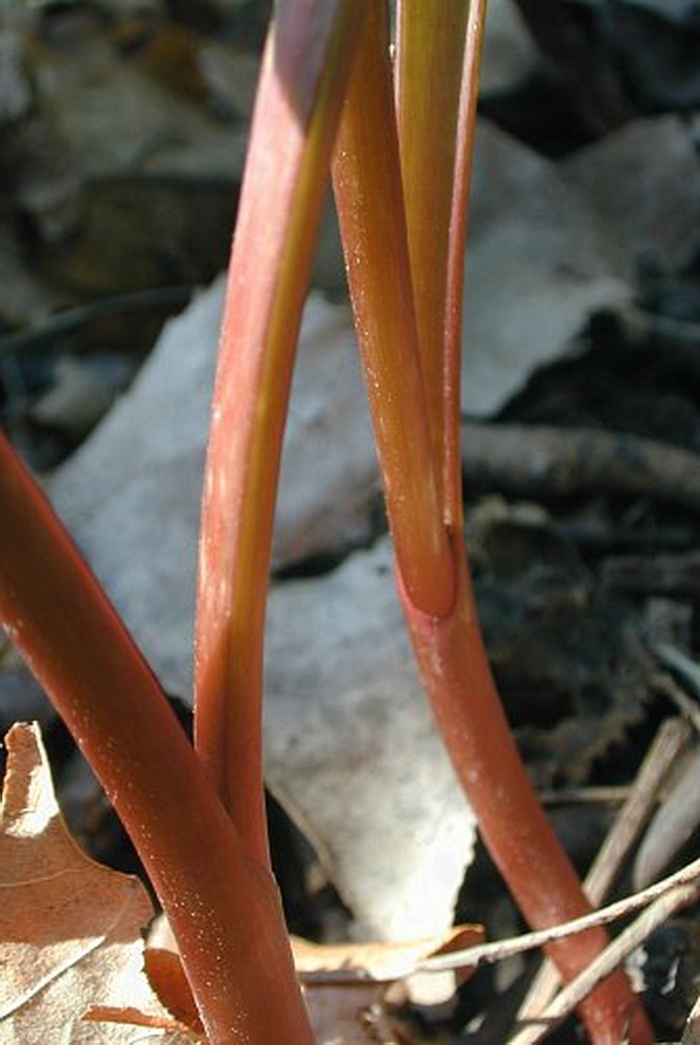
Comments: This woodland wildflower is somewhat unusual because its foliage has withered away by the time the flowers bloom. Both the foliage and flowers are attractive; the latter help to brighten the gloomy corners of woodlands during the summer. Wild Leek has the widest basal leaves (1½–3½" across) of any Allium sp. in the state. A similar species, Allium burdickii (which is also called 'Wild Leek'), has basal leaves that are about ½-1½" across. Other wild Allium spp. have leaves that are narrow and strap-like (less than ½" across). Wild Leek has about 20-40 flowers in each umbel, while Allium burdickii has 10-20 flowers in each umbel. Wild Leek has reddish leaf petioles and flowering stalks that are often reddish at the base, while the petioles and stalks of Allium burdickii are light green throughout. This latter species is restricted to wooded areas in NE Illinois and it is less common.
Cultivation: The preference is dappled sunlight during the spring when the basal leaves develop, while during the summer considerable shade is tolerated as the basal leaves have withered away. The soil should consist of a rich loose loam with abundant organic matter, while moisture levels should be more or less mesic. It is easiest to introduce new plants into an area by dividing and transplanting the bulbs during the fall.
Range & Habitat: The native Wild Leek occurs occasionally in central and northern Illinois, while in the southern section of the state it is rare or absent (see Distribution Map). Habitats include mesic deciduous woodlands and wooded bluffs. The presence of this species is a sign that the original flora of a woodlands is still in intact. An introduced species, Alliaria petiolata (Garlic Mustard), can shade out the basal leaves of Wild Leek during the spring, causing the latter to decline in abundance.

Faunal Associations: The flowers attract various kinds of bees, including Halictid bees, masked bees (Hylaeus spp.), honeybees, bumblebees, and mason bees. These insects suck nectar or collect pollen. To a lesser extent, the flowers are visited by Syrphid flies, which suck nectar or feed on pollen. Occasionally, the maggots of some flies feed on the bulbs of some Allium spp. (Onions), although not necessarily Wild Leek; these species include Delia antiqua (Onion Maggot), some Eumerus spp., and some Tritoxa spp. The plant bugs, Lindbergocapsus ainsliei and Lindbergocapsus allii, also feed on Allium spp. (Onions). Another species, Thrips tabaci (Onion Thrips), sucks juices from the foliage. Deer and other mammalian herbivores rarely browse on the foliage of Wild Leek.
Photographic Location: A mesic deciduous woodlands at Busey Woods in Urbana, Illinois.

Comments: This woodland wildflower is somewhat unusual because its foliage has withered away by the time the flowers bloom. Both the foliage and flowers are attractive; the latter help to brighten the gloomy corners of woodlands during the summer. Wild Leek has the widest basal leaves (1½–3½" across) of any Allium sp. in the state. A similar species, Allium burdickii (which is also called 'Wild Leek'), has basal leaves that are about ½-1½" across. Other wild Allium spp. have leaves that are narrow and strap-like (less than ½" across). Wild Leek has about 20-40 flowers in each umbel, while Allium burdickii has 10-20 flowers in each umbel. Wild Leek has reddish leaf petioles and flowering stalks that are often reddish at the base, while the petioles and stalks of Allium burdickii are light green throughout. This latter species is restricted to wooded areas in NE Illinois and it is less common.
0
0
文章
Miss Chen
2018年04月30日

Description: This plant is a summer annual about ½–2½' tall that is either unbranched or occasionally branched. The stems are light to medium green, terete, and glabrous to sparsely pubescent. The alternate leaves are more closely spaced together along the upper stems than the lower ones, providing the plant with a flat-topped appearance. The blades of individual leaves are up to 3" long and 2¼" across, medium green, ovate to broadly ovate, and crenate-serrate along the margins. The upper surfaces of the blades are sparsely covered with fine appressed hairs or they are hairless. The long slender petioles are up to 2½" long and light to medium green; they are covered with fine appressed hairs, or hairless. Sometimes the blades of the leaves droop from their petioles.
Deam's Mercury is monoecious with separate staminate (male) and pistillate (female) flowers on the same plant. Both types of flowers develop together from the axils of the leaves; they are surrounded by foliaceous floral bracts that are palmately divided into 5-9 lobes. Individual bracts are about ½" tall and a little longer across; they are light to medium green and either widely open or loosely folded in one direction. Individual lobes of the floral bracts are about ¼" long, lanceolate in shape, and ciliate. From the middle of each floral bract, the staminate flowers form a single spike-like raceme on a peduncle. Together, the raceme and its peduncle are about ½" long at maturity. Individual staminate flowers are less than 1/8" (3 mm.) across, consisting of a 4-lobed calyx, several stamens with yellow anthers, and no petals. There are also 1-3 pistillate flowers that areDistribution Map hidden at the base of each floral bract; individual pistillate flowers consist of an ovary with finely branched styles, insignificant sepals, and no petals. The ovary is sometimes finely hairy near its apex. The blooming period occurs from mid-summer into the fall and lasts about 2-3 months; only a few flowers are in bloom at the same time. Cross-pollination occurs by wind. Each ovary matures into a seed capsule (about ¼" across) that is globoid, slightly flattened, and 2-valved. Each valve of the capsule contains a single seed. Individual mature seeds are 2-3 mm. long (or longer), ovoid, and dark-colored. This plant reproduces by reseeding itself. The leaves become copper-colored during the fall.
Cultivation: The preference is dappled sunlight to medium shade, moist conditions, and soil consisting of sandy loam or gravelly loam. Most growth and development occurs during the summer and early fall.
Range & Habitat: The native Deam's Mercury is a rare plant that has been found in a few counties of east-central and southern Illinois. This plant is also uncommon in other states where it has been found. Habitats consist of bottomland woodlands along rivers, openings in bottomland woods, areas along paths in bottomland woods, woodland edges, and semi-shaded to shaded areas along roads. Deam's Mercury appears to prefer areas that are subjected to occasional flooding during the spring. Such areas typically have flood-deposited sand, silt, or gravel and scant ground vegetation.
Faunal Associations: The flea beetles Hornaltica bicolorata and Margaridisa atriventris feed on Acalypha spp. The seeds of these plants are eaten by the Mourning Dove and Swamp Sparrow, while White-Tailed Deer browse on the foliage (primarily during the summer and fall). Deam's Mercury and similar species lack the toxic white latex that is typical of species in the Spurge family (Euphorbiaceae).
Photographic Location: Along a path of a bottomland woodland near the Embarass River in Coles County, Illinois (Fox Ridge State Park).

Comments: Deam's Mercury is the least common native Acalypha spp. in Illinois. It has 2-valved seed capsules, larger seeds (exceeding 2 mm. long), and tends to have wider leaves than other Acalypha spp. It is most similar to the very common Acalypha rhomboidea, which has similar floral bracts with 5-9 lobes, but differs from this species in the characteristics that are mentioned above. In the past, Deam's Mercury has been regarded as a variety of Acalypha rhomboidea, but it is now considered a distinct species. Other common names of Acalypha deamii are Deam's Copperleaf, Large-Seeded Copperleaf, and Large-Seeded Mercury.
Deam's Mercury is monoecious with separate staminate (male) and pistillate (female) flowers on the same plant. Both types of flowers develop together from the axils of the leaves; they are surrounded by foliaceous floral bracts that are palmately divided into 5-9 lobes. Individual bracts are about ½" tall and a little longer across; they are light to medium green and either widely open or loosely folded in one direction. Individual lobes of the floral bracts are about ¼" long, lanceolate in shape, and ciliate. From the middle of each floral bract, the staminate flowers form a single spike-like raceme on a peduncle. Together, the raceme and its peduncle are about ½" long at maturity. Individual staminate flowers are less than 1/8" (3 mm.) across, consisting of a 4-lobed calyx, several stamens with yellow anthers, and no petals. There are also 1-3 pistillate flowers that areDistribution Map hidden at the base of each floral bract; individual pistillate flowers consist of an ovary with finely branched styles, insignificant sepals, and no petals. The ovary is sometimes finely hairy near its apex. The blooming period occurs from mid-summer into the fall and lasts about 2-3 months; only a few flowers are in bloom at the same time. Cross-pollination occurs by wind. Each ovary matures into a seed capsule (about ¼" across) that is globoid, slightly flattened, and 2-valved. Each valve of the capsule contains a single seed. Individual mature seeds are 2-3 mm. long (or longer), ovoid, and dark-colored. This plant reproduces by reseeding itself. The leaves become copper-colored during the fall.
Cultivation: The preference is dappled sunlight to medium shade, moist conditions, and soil consisting of sandy loam or gravelly loam. Most growth and development occurs during the summer and early fall.
Range & Habitat: The native Deam's Mercury is a rare plant that has been found in a few counties of east-central and southern Illinois. This plant is also uncommon in other states where it has been found. Habitats consist of bottomland woodlands along rivers, openings in bottomland woods, areas along paths in bottomland woods, woodland edges, and semi-shaded to shaded areas along roads. Deam's Mercury appears to prefer areas that are subjected to occasional flooding during the spring. Such areas typically have flood-deposited sand, silt, or gravel and scant ground vegetation.
Faunal Associations: The flea beetles Hornaltica bicolorata and Margaridisa atriventris feed on Acalypha spp. The seeds of these plants are eaten by the Mourning Dove and Swamp Sparrow, while White-Tailed Deer browse on the foliage (primarily during the summer and fall). Deam's Mercury and similar species lack the toxic white latex that is typical of species in the Spurge family (Euphorbiaceae).
Photographic Location: Along a path of a bottomland woodland near the Embarass River in Coles County, Illinois (Fox Ridge State Park).

Comments: Deam's Mercury is the least common native Acalypha spp. in Illinois. It has 2-valved seed capsules, larger seeds (exceeding 2 mm. long), and tends to have wider leaves than other Acalypha spp. It is most similar to the very common Acalypha rhomboidea, which has similar floral bracts with 5-9 lobes, but differs from this species in the characteristics that are mentioned above. In the past, Deam's Mercury has been regarded as a variety of Acalypha rhomboidea, but it is now considered a distinct species. Other common names of Acalypha deamii are Deam's Copperleaf, Large-Seeded Copperleaf, and Large-Seeded Mercury.
0
0
文章
Miss Chen
2018年04月22日

Description: This perennial wildflower is 1½–3' tall and more or less erect, forming occasional side branches. The stems usually have lines of hair, although sometimes they are glabrous; young stems are light to medium green, while older stems become brown. The alternate leaves along these stems are up to 4" long and ¾" across; they are narrowly ovate, lanceolate, or oblanceolate, smooth along the margins, and sessile. The upper surface of each leaf is dark green and hairless. The central stem terminates in a panicle of flowerheads that is usually longer than wide; some of the side stems also produce flowerheads in smaller panicles. The branches of each panicle are stiffly ascending; they are covered with small scale-like bracts. Each flowerhead is about ¾–1½" across, consisting of 15-25 ray florets and a similar number of disk florets. The ray florets are lavender to blue-violet, while the disk florets are yellow to reddish purple. Both kinds of florets are fertile. The base of each mature flowerhead (the involucre) is often shaped like a top or turban (turbinate) and it is about 7-11 mm. in length. The exterior of the involucre is covered with appressed scales (phyllaries) in several series; the apex of each scale is obtuse, rather than pointed. The blooming period occurs during early to mid-fall and lasts about 3 weeks. Each floret is replaced by an achene with a tuft of tawny hairs. This small achene is oblongoid with several ribs and often finely pubescent. On mature plants, the root system consists of a woody caudex with fibrous roots underneath. Occasionally, rhizomes are produced that can form vegetative offsets.
Cultivation: The preference is partial sun, mesic to slightly dry conditions, and a loamy or rocky soil with a somewhat acidic pH. The lower leaves often become withered or discolored before the blooming period occurs during the fall. If this wildflower is spoiled in the garden with fertilizer and too much water, it may become top-heavy and require staking later in the year.
Range & Habitat: The native Turbinate Aster is occasional in the southern half of Illinois and absent in the northern half of the state (see Distribution Map). Illinois lies in the NE corner of its range in the United States. Habitats include prairies, savannas, openings in upland woodlands, borders of upland woodlands, thinly wooded slopes and bluffs, cliffs, rocky glades, and roadsides. This species is often found where sandstone, chert, or granite is close to the surface of the ground.
Faunal Associations: The nectar and pollen of the flowers attract various bees, bee flies, butterflies, skippers, and other insects. Bee visitors include honeybees, bumblebees, leaf-cutting bees (Megachile spp.), digger bees (Melissodes spp.), and Halictid bees. The caterpillars of the butterflies Chlosyne nycteis (Silvery Checkerspot) and Phyciodes tharos (Pearl Crescent) feed on the foliage of asters (Symphyotrichum spp.); the caterpillars of many species of moths also feed on various parts of asters. Leaf Beetles that often feed on asters include Exema canadensis, Microrhopala xerene, Ophraella pilosa, and Sumitrosis inaequalis. The value of asters to vertebrate animals is somewhat limited. The Wild Turkey sometimes eats the seeds and foliage; White-Tailed Deer and the Cottontail Rabbit also eat the foliage.

Photographic Location: The wildflower garden of the webmaster in Urbana, Illinois.
Comments: This aster is one of the last wildflowers to bloom during the fall. It has attractive flowerheads that are larger than average in size; underneath these flowerheads, the stiffly ascending branches appear nearly naked because their scale-like bracts are so small. The Turbinate Aster (Symphyotrichum turbinellum) can be distinguished from other asters (Symphyotrichum spp.) as follows: 1) its flowerheads are at least ¾" across, 2) the branches of each panicle are covered with small scale-like bracts, 3) the leaves along the stems are sessile and never cordate at the base, 4) the margins of the leaves are entire or slightly crenate, 5) the tips of the phyllaries are obtuse, rather than pointed, and 6) the stems often have lines of hairs. Sometimes, this wildflower is called the Prairie Aster, but it is more common in savannas or thin upland woodlands (at least in Illinois).
Cultivation: The preference is partial sun, mesic to slightly dry conditions, and a loamy or rocky soil with a somewhat acidic pH. The lower leaves often become withered or discolored before the blooming period occurs during the fall. If this wildflower is spoiled in the garden with fertilizer and too much water, it may become top-heavy and require staking later in the year.
Range & Habitat: The native Turbinate Aster is occasional in the southern half of Illinois and absent in the northern half of the state (see Distribution Map). Illinois lies in the NE corner of its range in the United States. Habitats include prairies, savannas, openings in upland woodlands, borders of upland woodlands, thinly wooded slopes and bluffs, cliffs, rocky glades, and roadsides. This species is often found where sandstone, chert, or granite is close to the surface of the ground.
Faunal Associations: The nectar and pollen of the flowers attract various bees, bee flies, butterflies, skippers, and other insects. Bee visitors include honeybees, bumblebees, leaf-cutting bees (Megachile spp.), digger bees (Melissodes spp.), and Halictid bees. The caterpillars of the butterflies Chlosyne nycteis (Silvery Checkerspot) and Phyciodes tharos (Pearl Crescent) feed on the foliage of asters (Symphyotrichum spp.); the caterpillars of many species of moths also feed on various parts of asters. Leaf Beetles that often feed on asters include Exema canadensis, Microrhopala xerene, Ophraella pilosa, and Sumitrosis inaequalis. The value of asters to vertebrate animals is somewhat limited. The Wild Turkey sometimes eats the seeds and foliage; White-Tailed Deer and the Cottontail Rabbit also eat the foliage.

Photographic Location: The wildflower garden of the webmaster in Urbana, Illinois.
Comments: This aster is one of the last wildflowers to bloom during the fall. It has attractive flowerheads that are larger than average in size; underneath these flowerheads, the stiffly ascending branches appear nearly naked because their scale-like bracts are so small. The Turbinate Aster (Symphyotrichum turbinellum) can be distinguished from other asters (Symphyotrichum spp.) as follows: 1) its flowerheads are at least ¾" across, 2) the branches of each panicle are covered with small scale-like bracts, 3) the leaves along the stems are sessile and never cordate at the base, 4) the margins of the leaves are entire or slightly crenate, 5) the tips of the phyllaries are obtuse, rather than pointed, and 6) the stems often have lines of hairs. Sometimes, this wildflower is called the Prairie Aster, but it is more common in savannas or thin upland woodlands (at least in Illinois).
0
0



